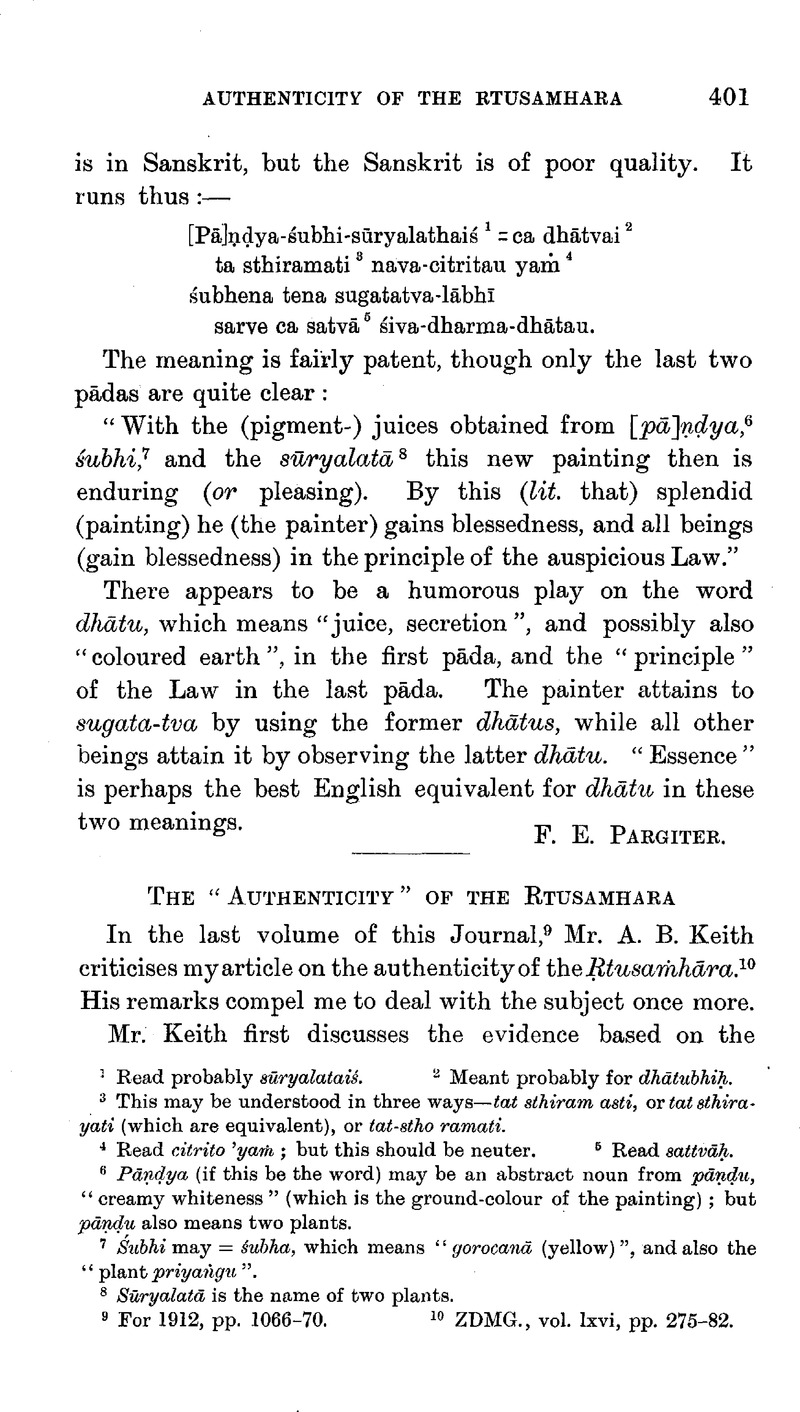No CrossRef data available.
Article contents
The “Authenticity” of the Ṛtusaṁhāra
Published online by Cambridge University Press: 15 March 2011
Abstract

- Type
- Miscellaneous Communications
- Information
- Copyright
- Copyright © The Royal Asiatic Society 1913
References
page 401 note 1 Read probably sūryalataiś.
page 401 note 2 Meant probably for dhātubhiḥ.
page 401 note 3 This may be understood in three ways—tat sthiram asti, or tat sthirayati (which are equivalent), or tat-stho ramati.
page 401 note 4 Read citrito 'yaṁ; but this should be neuter.
page 401 note 5 Read sattvāḥ.
page 401 note 6 Pāṇḍya (if this be the word) may be an abstract noun from pāṇḍu, “creamy whiteness” (which is the ground-colour of the painting); but pāṇḍu also means two plants.
page 401 note 7 Śubhi may = śubha, which means “gorocanā (yellow)”, and also the “plant priyaṅgu”.
page 401 note 8 Sūryalatā is the name of two plants.
page 401 note 9 For 1912, pp. 1066–70.
page 401 note 10 ZDMG., vol. lxvi, pp. 275–82.Google Scholar
page 403 note 1 See Professor Hultzsch in his preface to the Meghadūta, p. ix.Google Scholar
page 403 note 2 Viz. in Vallabhadeva's Subhāṣitāvali, Nos. 1674; 1678 (= Ṛt. vi, 16; 19). See Dr. F. W. Thomas in his book Kavīndravacanasamuccaya: A Sanskrit Anthology of Verses, ed. with introduction and notes by F. W. Thomas. Calcutta, 1912 (Bibl. Ind., n.s., No. 1309), pp. 30 seqq.
page 404 note 1 See Professor Hultzsch, loc. cit., p. x seq.
page 404 note 2 In Professor Hultzsch's edition.
page 404 note 3 In v, 10, pracaṇḍasūryātapatāpitā; v, 11Google Scholar, pracaṇḍātapatāpitā; v, 20Google Scholar, sūryātapatāpitaḥ.
page 404 note 4 Cf. also i, 2d; v, 2d. i, 7b; vi, 13a.
page 405 note 1 At the end of section 4 Mr. Keith himself admits “that the repetition in the Meghadūta seems more artistic than in the Ṛtusaṁhāra”.
page 405 note 2 A History of Sanskrit Literature, by Macdonell, Arthur A., London, 1905, p. 337.Google Scholar
page 405 note 3 See i, 3–10, 12, 28; ii, 2, 10–12, 18–22, 24, 25; iii, 9, 19, 20, 23–6; iv, 2–7, 11–17; v, 3–16; vi, 1, 4–13, 15, 16, 18, 21, 26, 27. The list omits all verses which contain e.g. merely an Upamā of erotic nature.
page 406 note 1 In his Appendix to the Catalogue of Sanskrit MSS. in the Bodleian Library, Oxford, 1909, p. 28, No. 217, Mr. Keith asserts the same by saying: “the style and manner [of the Ṛtusaṁhāra] are entirely those of Kālidāsa.”
page 406 note 2 Beiträge zur älteren Geschichte der Alaṃhāraśāstra, Berlin, 1911, p. 9.Google Scholar
page 407 note 1 About this Alaṁkāra see Nobel, , Beiträge zur älteren Geschichte des Alaṃkāraśāstra, pp. 67 seqq.Google Scholar
page 409 note 1 The word kavi does not correspond to the English “poet”. The authors of the Mahābhārata or of the Vedic hymns cannot be called kavis, nor are their works kāvyas.


